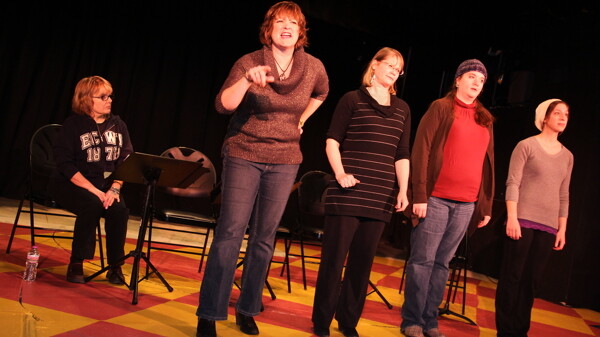Dressed to Impress
CVTG production explores the lives and wardrobes of generations of women
Katie Bast, photos by Andrea Paulseth |

of Love, Loss, and What I Wore.
The play featured at the Grand Theatre in February isn’t a romantic drama in the spirit of Valentine’s Day, but rather a play composed of monologues told by five women telling their life stories and how their clothing played a role.
“There are some major truths in this show about the standards we have as women and the standards that other people have for us appearance-wise,” cast member Natalie Leighton said. “It’s not solely for women, but I just know it’s really going to hit home with women of all ages and backgrounds.”
From Feb. 7-15, the Chippewa Valley Theatre Guild will perform Love, Loss, and What I Wore, a monologue-based play written by sisters Nora and Delia Ephron.
Director Jake Lindgren describes the show as funny, simple and comfortable, with moments of poignancy.
“There are some major truths in this show about the standards we have as women and the standards that other people have for us appearance-wise.” – cast member Natalie Leighton on Love, Loss, and What I Wore
“We’ve cried as an ensemble as these stories are starting to flesh out. There are notes that are hit that dredge up some of the darker stuff in our past,” he said. “It’s a very relatable story across the board.”
Love, Loss, and What I Wore isn’t a typical performance. It’s a reader’s theater piece, meaning the actors are situated on stools at the front of the stage with their scripts on lecterns in front of them.
This eliminates the need for costume changes, blocking, and staging, Lindgren said.
“It’s been very nice to just really focus on the characters and the storytelling,” he said. “The words they’re saying and why they’re saying them … all the little things you sometimes have to race through.”
Rozie Bejin plays Gingy, an older, wiser woman looking back on her life and summarizing the big picture. As the play opens, Gingy explains how she started thinking about all the dresses she had worn throughout her life and decided to draw pictures of her clothes as a way to hold onto them.
When finished drawing, she realized her drawings told a story. A picture of Gingy’s Brownie uniform flashes on a screen, prompting Gingy to tell the first of her six life stories which are interspersed throughout the play’s 26 scenes. The play covers a broad timeline, starting with the late 1940s.
“The play has a variety of formats periodically seasoned with the pizzazz of universal one-liner comments all women share when talking about clothes, their bodies and shopping,” Bejin said.
Kimberly Butnick, Karen Fennimore, Rhiannon Schaub, and Leighton each play multiple characters throughout the show, sharing their stories provoked by memories of clothing. Their anecdotes cover a wide spectrum of emotions, experiences and stages in life.
Lindgren said the ensemble plays a supplemental role to Gingy. Sometimes they are featured individually to read monologues, but many of them interact with Gingy to help her tell her stories.
Despite the monologue style, Leighton said the actresses still interact with one another. She said they each have a couple of their own monologues, but there are also instances where they piggyback off one another.
Lindgren said the play is a gathering of women sharing their life stories and experiences and bonding over them.
Throughout the rehearsal process, the cast and crew have been able to share their stories with each other as well, which has lent itself nicely to the production. The stories in the play trigger cast members’ memories, which in turn, benefit the performance.
“It’s been very luxurious for me to be able to hear a story from one of the actresses and then say, ‘Use that in the story. Use the emotion you felt in that experience,’ ” Lindgren said.
Leighton said getting to know the other actresses off stage has also helped their performances on stage.
“These are women I’ve never worked with before,” she said. “Because of our differences in age and differences in life experience, it’s just been super fun to have a coffee-talk perspective because we want to keep things really light and really genuine when we’re up there on stage.”
While Lindgren said the most obvious audience is women, he doesn’t want to alienate men.
“As men, we’re not going to relate on the same level, but we’re going to relate because, ‘Yep, you have that purse and you can never find anything in it,’ ” Lindgren said. “We’ve experienced it from a different point of view.”
Bejin said the play is about more than just clothing and said it will make people think. “It opens itself up for people and friends to have discussions of their own clothes and their own stories and backgrounds,” Bejin said. “It lends itself to a lot of discussion among friends.”
It may not be the stereotypical theater-going experience, but Leighton said it’s worth it.
“It’s a new experience in theater,” Leighton said. “It’s probably not what you’re expecting but if you come in with an open mind and want to laugh and hear issues in your life told through other people’s perspectives, it would be just a great night out.”
Love, Loss, And What I Wore runs at the Grand Theatre, 102 W. Grand Ave., Feb. 7-8, 14-15 at 7:30pm with a matinee Feb. 9 at 1:30pm. See Full Slate for more details.




















